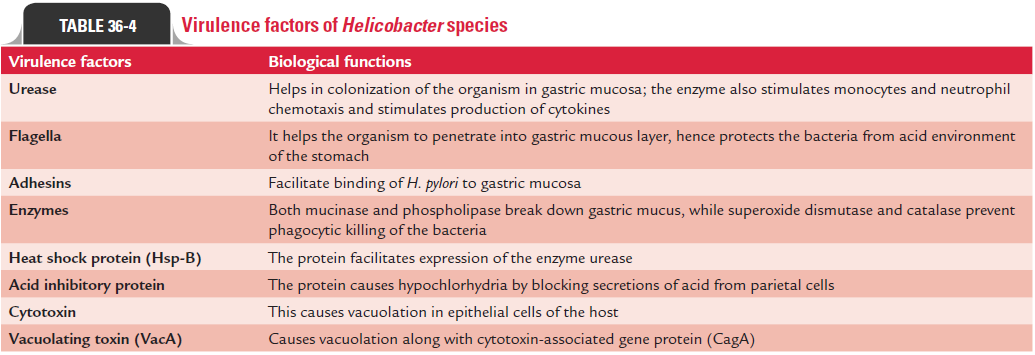Chapter: Microbiology and Immunology: Bacteriology: Campylobacter and Helicobacter
Pathogenesis and Immunity - Helicobacter pylori
Pathogenesis and Immunity
H. pylori characteristically cause (a) alteration of gastricacid production, (b) gastric inflammation, and (c) tissue destruction.
◗ Virulence factors
pylori produces several virulence factors that contribute tothe pathogenesis of disease (Table 36-4).
1. Urease: The enzyme urease is a very important factor forcolonization of H. pylori in the gastric mucosa. The enzyme pro-duces ammonia from urea, which in turn increases the pH of the gastric mucosa in the immediate vicinity of the bacterial cell. It helps, therefore, to neutralize gastric acidity and also in colonization of the organism in gastric mucosa. The enzyme also stimulates monocytes and neutrophil chemotaxis and stimulates production of cytokines.

2. Flagella: Flagella are also very important for colonizationof H. pylori. These help the organism to penetrate into gastric mucous layer; hence, it is protected from acidic environment of the stomach.
3. Adhesins: These include hemagglutinin, sialic acid-bindingadhesins, and Lewis blood group adhesins. All these factors facilitate binding of H. pylori to gastric mucosa.
4. Enzymes: H. pyloriproduces many enzymes, such as muci-nase, phospholipases, superoxide dismutase, and catalase. Both mucinase and phospholipase break down gastric mucus, while superoxide dismutase and catalase prevent phagocytic killing of the bacteria.
5. Heat shock protein (Hsp-B): The heat shock protein facili-tates expression of the enzyme urease.
6. Acid inhibitory protein: This protein causes hypochlorhy-dria by blocking secretions of acid from parietal cells.
7. Cytotoxin: This causes vacuolation in epithelial cells of thehost.
◗ Pathogenesis of H. pylori infection
H. pylori infection begins by colonization of gastric mucosa,which is facilitated by many virulence factors. H. pylori blocks the production of acid by its acid-inhibitory protein and also neutralizes the gastric acidity by production of ammo-nia by splitting urea by the enzyme urease. The biological activity of urease is enhanced further by heat shock proteins. Subsequently, Helicobacter through their active cork screw motility pass through gastric mucosa and adhere to epithelial cells. The adhesion is mediated by many adhesin proteins, such as hemagglutinin, sialic acid-binding adhesin, and Lewis blood group adhesin. H. pylori are protected from phagocytosis and intracellular killing by enzymes, such as elastases and superox-ide dismutase. After adhesion, damage to the epithelial cells is caused by multiple factors, such as mucinases, phospholipases, and vacuolating aflatoxin and by products of urease. Finally, Helicobacter infection causes atrophic and even metaplasticchanges in the stomach.
◗ Host immunity
H. pylori infection induces the production of IgM, IgG, and IgAantibodies and also cellular immunity, but they do not appear to confer any protection against the disease.
Related Topics